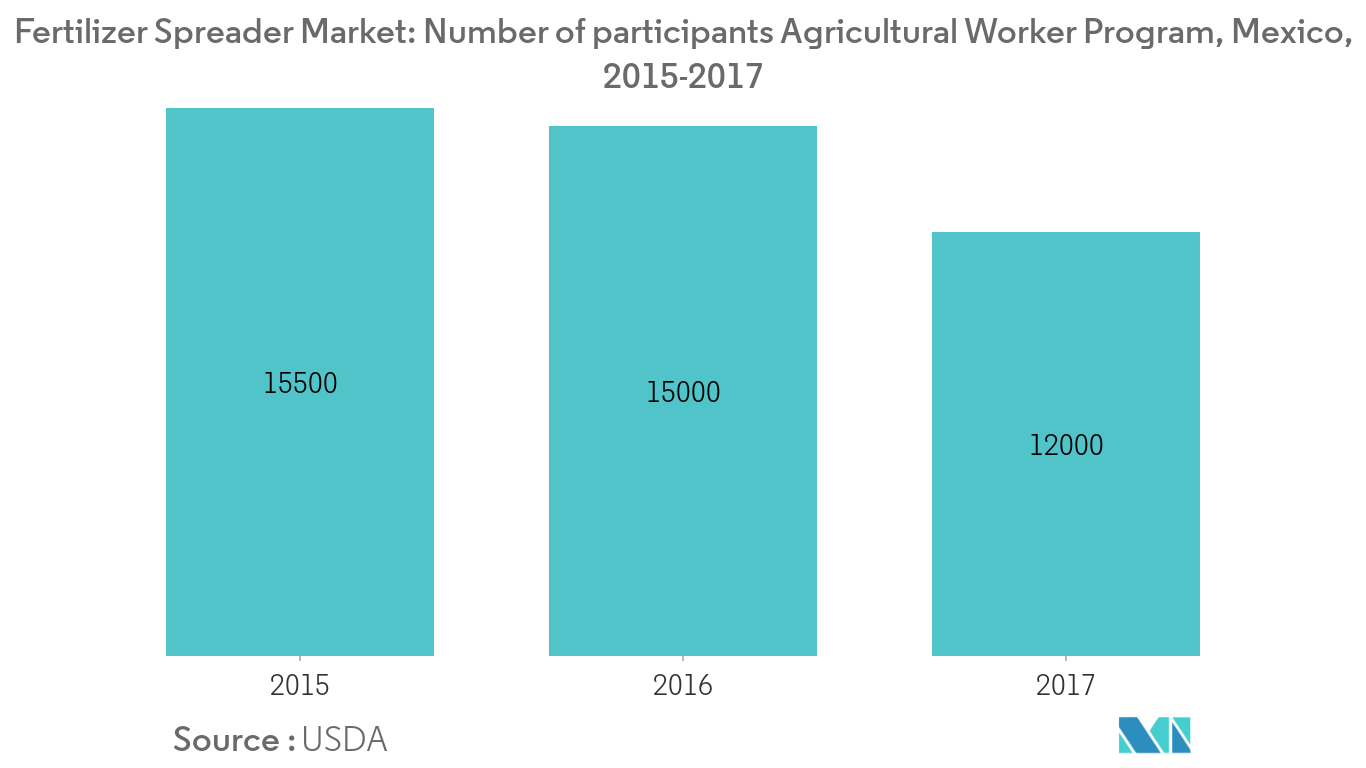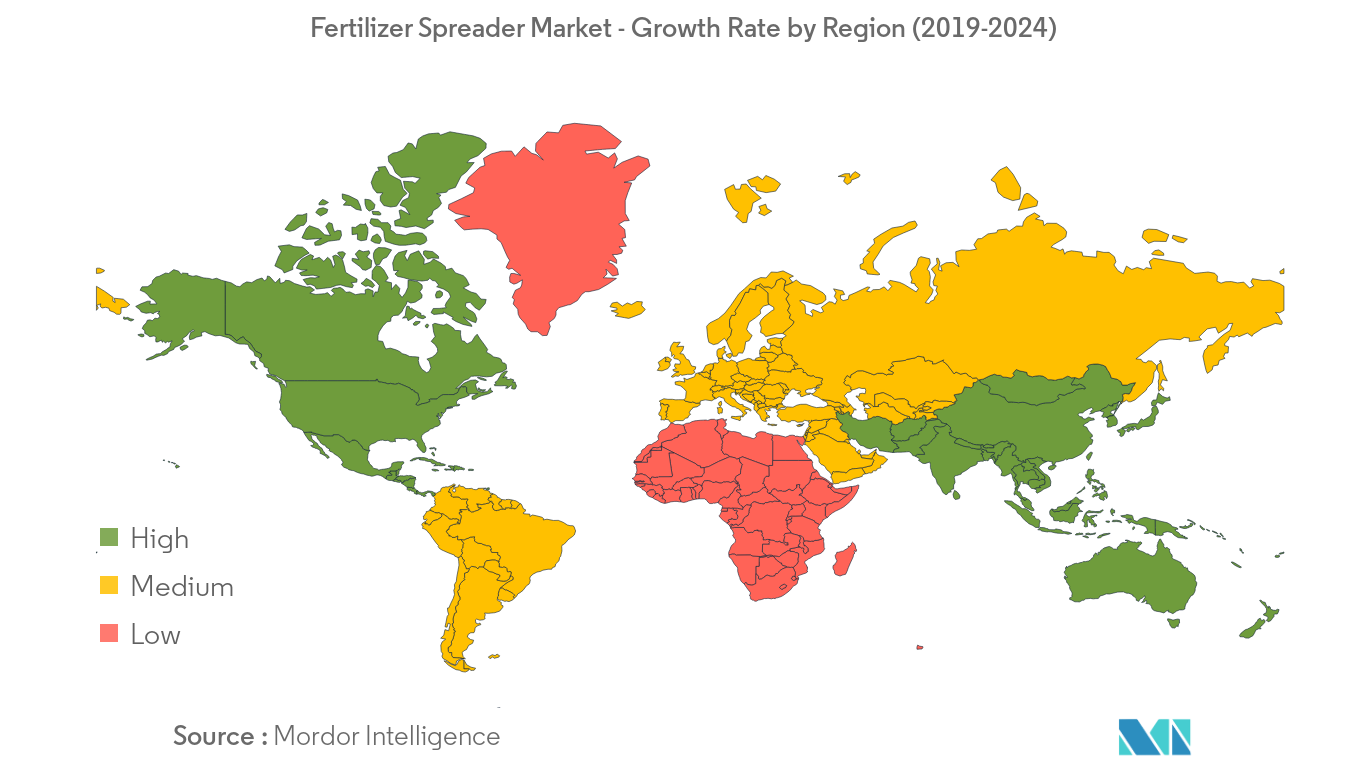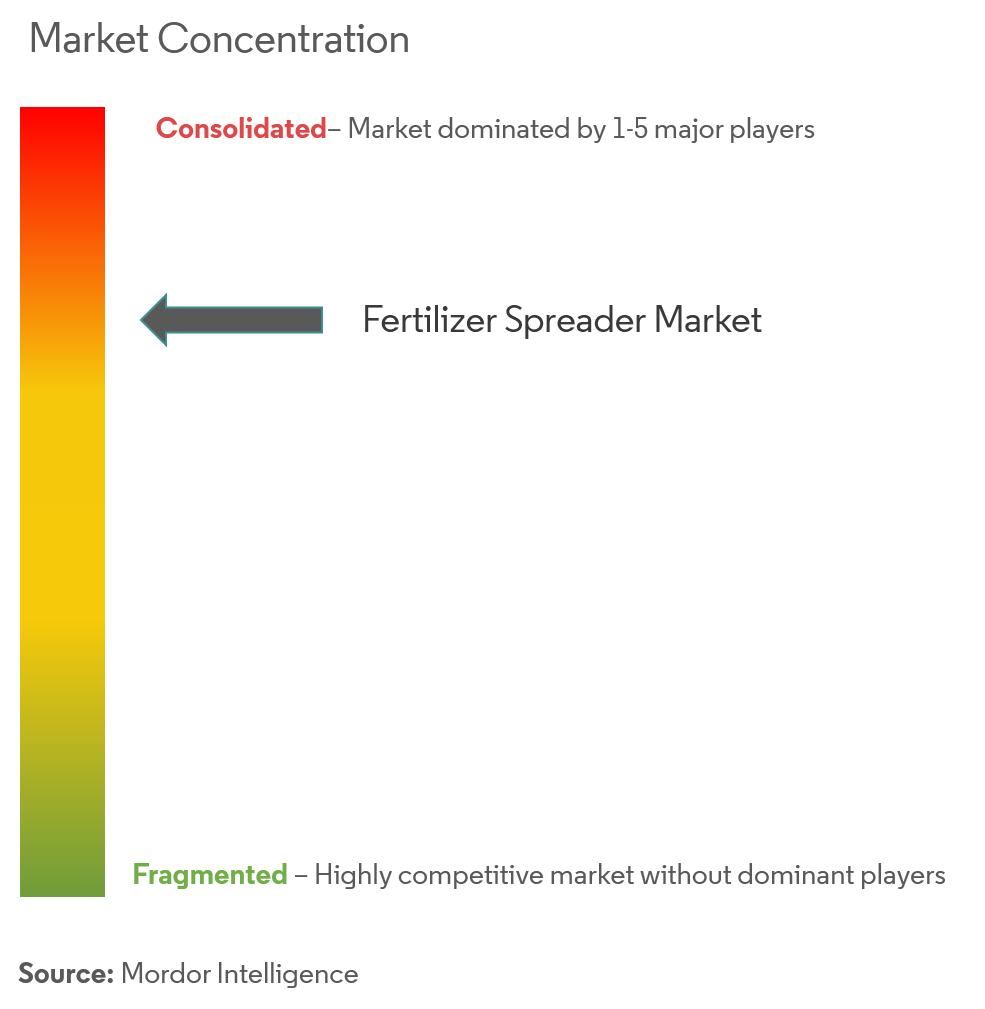Fertilizer Spreaders Market Size

| Study Period | 2019 - 2029 |
| Base Year For Estimation | 2023 |
| CAGR | 3.90 % |
| Fastest Growing Market | North America |
| Largest Market | Asia Pacific |
| Market Concentration | Low |
Major Players
*Disclaimer: Major Players sorted in no particular order |
Need a report that reflects how COVID-19 has impacted this market and its growth?
Fertilizer Spreaders Market Analysis
Fertilizer Spreader Market is projected to grow at a CAGR of 3.9% during the forecast period (2020-2025)
- The ever-increasing credit facility available for the farmers and the growing concern over food security is driving the market for fertilizer spreadersin the country. Starting with the demand for basic machineries like tractors, ploughs, and threshers, the current demand and invention are focused on pre-harvest and post-harvest machinery like seeders, sprayers, threshers, harvesters, drilling machines etc.
- In developed regions such as Europe and North America, the rate of adoption of technology is considerably high. This is majorly due to high per capita income, thus most farmers or manufacturers rely on machinery, such as spreaders becausethis equipment reduces work and saves time that can be allocated for some other work.
Fertilizer Spreaders Market Trends
Acute Farm Labor Shortage and Aging Hired Farm Workforce
Farmers pressure their governments to facilitate the immigration of farmworkers from poorer countries to fill the void. Even if there is an abundance of farm labor overall, local labor shortages often materialize if workers are not available in the right place at the right time. Acute farm labor crunch has surfaced in the world in recent years. A survey by the California Farm Bureau has revealed that more than 40% of the farmers have faced a consistent labor shortage for various farm operations for the past five years, which has further led to an increased usage of spreaders. According to a report by USDA, 2018, the agricultural worker participants decreased from 15,500 in 2015 to 12,000 in 2017 as bringing large numbers of workers from Asia would be more expensive and challenging logistically to work in Mexico. Thus, with a reduced dependency on labor and resulting in increased efficiency, farmers have started relying on machineries, such as, spreaders and harvesters for rapid cultivation, which is expected to drive the demand for spreaders during the forecast period.

Asia-Pacific Dominates the Fertilizer Spreader Market
Asia-Pacific dominates the global fertilizer spreader market owing to increasing dependence on fertilizers for improver crop productivity. North America and Europe regions are expected to grow with significant CAGR due to the high rate of technology adoption and high per capita income in this region. The progress of South-North water transfer plant project in China, anticipated to complete by 2050, would deploy various construction machinery either by leasing or owning the machinery, thus growing the demand for construction machinery over next three decades. The increasing number of dam construction, real-estate business, commercial and residential complexes, and expansion of rail and road infrastructure in the APAC region are few drivers for the construction machinery market.

Fertilizer Spreaders Industry Overview
The global fertilizer spreadermarket is characterized by the presence of numerous international and regional players, resulting in a moderately competitive market environment.Some of the major companies that dominated the market studied are AGCO Corporation,CNH Industrial N.V, Deere & Company, Kubota Corporation, and Buhler Industries,capturing a certain portion of market share in 2019.
Fertilizer Spreaders Market Leaders
AGCO Corporation
CNH Industrial N.V.
Deere & Company
Kubota Corporation
Kasco Manufacturing Co., Inc.
*Disclaimer: Major Players sorted in no particular order

Fertilizer Spreaders Market Report - Table of Contents
-
1. INTRODUCTION
-
1.1 Study Deliverables
-
1.2 Study Assumptions
-
1.3 Scope of the Study
-
-
2. RESEARCH METHODOLOGY
-
3. EXECUTIVE SUMMARY
-
4. MARKET DYNAMICS
-
4.1 Market Overview
-
4.2 Introduction to Market Drivers and Restraints
-
4.3 Market Drivers
-
4.4 Market Restraints
-
4.5 Industry Attractiveness - Porter's Five Force Analysis
-
4.5.1 Threat of New Entrants
-
4.5.2 Bargaining Power of Buyers/Consumers
-
4.5.3 Bargaining Power of Suppliers
-
4.5.4 Threat of Substitute Products
-
4.5.5 Intensity of Competitive Rivalry
-
-
-
5. MARKET SEGMENTATION
-
5.1 Machinery Type
-
5.1.1 Dry Fertilizers Spreader
-
5.1.2 Drop Spreaders
-
5.1.3 Rotary Spreaders
-
5.1.4 Liquid Fertilizer Spreaders/Sprays
-
5.1.5 Others
-
-
5.2 Geography
-
5.2.1 North America
-
5.2.1.1 US
-
5.2.1.2 Canada
-
5.2.1.3 Mexico
-
5.2.1.4 Rest of North America
-
-
5.2.2 Europe
-
5.2.2.1 Germany
-
5.2.2.2 UK
-
5.2.2.3 France
-
5.2.2.4 Russia
-
5.2.2.5 Spain
-
5.2.2.6 Rest of Europe
-
-
5.2.3 Asia Pacific
-
5.2.3.1 China
-
5.2.3.2 Japan
-
5.2.3.3 India
-
5.2.3.4 South Korea
-
5.2.3.5 Rest of Asia-Pacific
-
-
5.2.4 South America
-
5.2.4.1 Brazil
-
5.2.4.2 Argentina
-
5.2.4.3 Rest of South America
-
-
5.2.5 Middle East and Africa
-
5.2.5.1 South Africa
-
5.2.5.2 Egypt
-
5.2.5.3 Rest of Middle East and Africa
-
-
-
-
6. COMPETITIVE LANDSCAPE
-
6.1 Market Share Analysis
-
6.2 Most Adopted Strategy
-
6.3 Company Profiles
-
6.3.1 AGCO Corporation
-
6.3.2 CNH Industrial N.V.
-
6.3.3 Deere and Company
-
6.3.4 Kubota
-
6.3.5 Kasco Manufacturing
-
6.3.6 Kuhn Group
-
6.3.7 Kverneland AS
-
6.3.8 Mahindra & Mahindra
-
6.3.9 CLASS
-
6.3.10 IRIS Spreaders Co., Ltd.
-
6.3.11 Techint Group
-
-
-
7. MARKET OPPORTUNITIES AND FUTURE TRENDS
Fertilizer Spreaders Industry Segmentation
Fertilizer Spreader is a device used for scattering bulk materials, especially, manure or fertilizer, over a relatively wide area. Spreader Fertilizers Machinery Market includes the latest trends, growth factors, major companies, competitive landscape, regional market share, Porter’s framework analysis and, investment opportunities. Spreader equipment which is used in agricultural practices is only considered. Industrial applications are not a part of this report. The component segment of the report does not include the after-sales market. Hence, they are considered as one-time investment products. Market size estimations for the forecast years were in real terms. The average selling price (ASP) was kept constant throughout the forecast period for each country.
| Machinery Type | |
| Dry Fertilizers Spreader | |
| Drop Spreaders | |
| Rotary Spreaders | |
| Liquid Fertilizer Spreaders/Sprays | |
| Others |
| Geography | ||||||||
| ||||||||
| ||||||||
| ||||||||
| ||||||||
|
Fertilizer Spreaders Market Research FAQs
What is the current Fertilizer Spreader Market size?
The Fertilizer Spreader Market is projected to register a CAGR of 3.9% during the forecast period (2024-2029)
Who are the key players in Fertilizer Spreader Market?
AGCO Corporation, CNH Industrial N.V., Deere & Company, Kubota Corporation and Kasco Manufacturing Co., Inc. are the major companies operating in the Fertilizer Spreader Market.
Which is the fastest growing region in Fertilizer Spreader Market?
North America is estimated to grow at the highest CAGR over the forecast period (2024-2029).
Which region has the biggest share in Fertilizer Spreader Market?
In 2024, the Asia Pacific accounts for the largest market share in Fertilizer Spreader Market.
What years does this Fertilizer Spreader Market cover?
The report covers the Fertilizer Spreader Market historical market size for years: 2019, 2020, 2021, 2022 and 2023. The report also forecasts the Fertilizer Spreader Market size for years: 2024, 2025, 2026, 2027, 2028 and 2029.
Fertilizer Spreaders Industry Report
Statistics for the 2024 Fertilizer Spreaders market share, size and revenue growth rate, created by Mordor Intelligence™ Industry Reports. Fertilizer Spreaders analysis includes a market forecast outlook 2029 and historical overview. Get a sample of this industry analysis as a free report PDF download.
